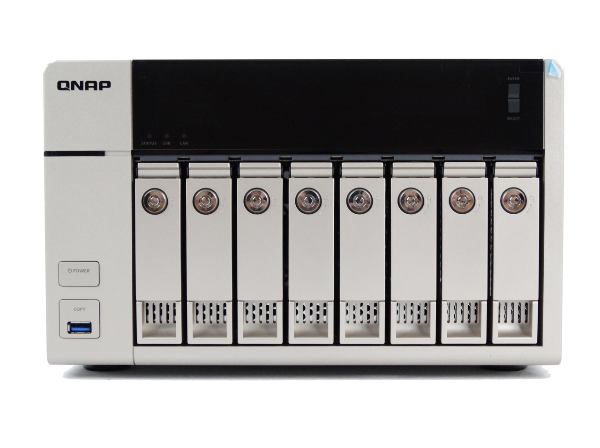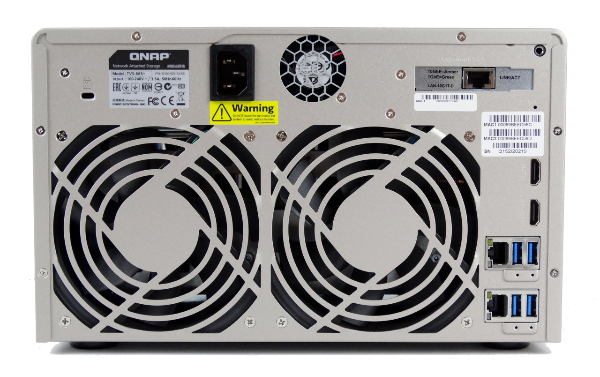QNAP TVS-863+ 8-Bay NAS Review
Why you can trust Tom's Hardware
A Closer Look
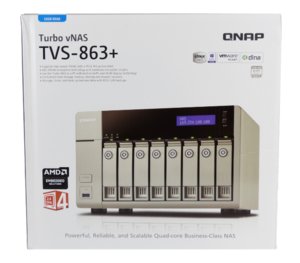
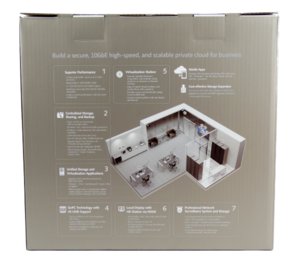
The QNAP TVS-863+ ships in a full retail package that gives shoppers a lot of relevant information in a retail environment.
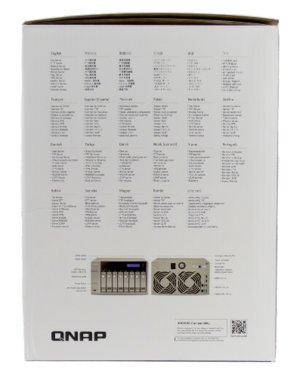
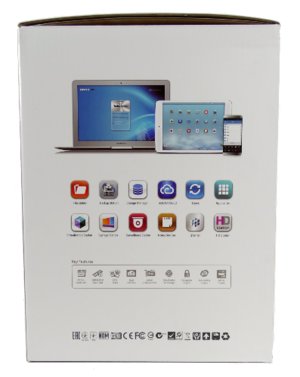
Most SMB NAS products are sold online in North America, but we give QNAP kudos for printing the information on the package. In some countries you can find NAS in retail stores or computer malls.
Inside the package, we found the TVS-863+ secured in closed cell foam with the accessories in a separate compartment from the main unit. The corners are well protected, making it very unlikely for this model to be damaged during shipping.

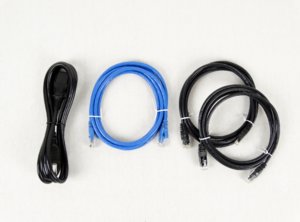
The TVS-863+ ships with a quick installation guide, fine and coarse screws for mounting 2.5-inch and 3.5-inch drives and two sets of keys for the locking drive bays. The system also ships with a power cables and three Ethernet cables.
The gold standard? The TVS-x63 series comes in a champagne gold color that is popular in home theater products in Japan. I'm not sure if that was QNAP's inspiration for producing this series in gold rather than the traditional black, but it's a nice change-up in the test lab.
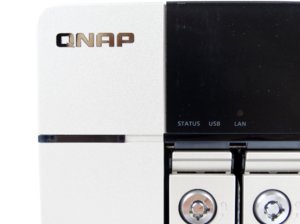
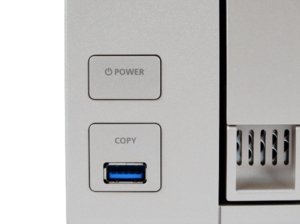
The system allows users to see IO activity in a number of ways. LAN and USB LEDs on the front fascia indicate activity and LEDs that shine through the drive bays also show disk connectivity for the bay and activity. A long, thin LED-lit area on the far left indicates power.
The power button to turn the system on is just above the one-touch-copy USB 3.0 port. To shut the system down you need to hold the power button. It's a thoughtful feature given the nearness to the copy function for external storage devices.
Get Tom's Hardware's best news and in-depth reviews, straight to your inbox.
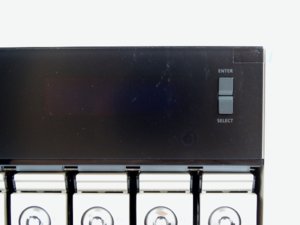
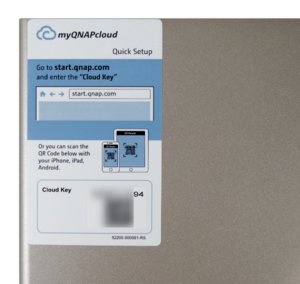
The front LED display gives system status information and warns in the event of a drive failure. The display is useful for the initial setup as it displays the number of loaded drives, IP and other useful information.
A sticker on top of the system gives users the key to connect to QNAP's myQNAPcloud feature for mobile devices.
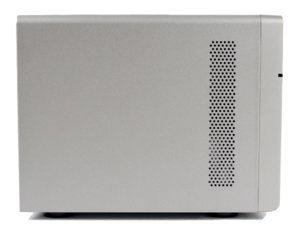
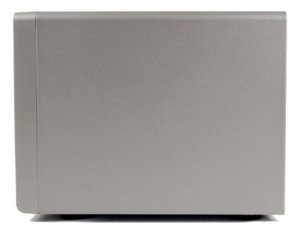
The system is designed so most of the air flow passes over the hard drives to keep them cool. The compute side does have vents so air can pass through to keep the processor, chipset and RAM cool.
The back of the system has a majority of the IO ports. This is a full feature system with four USB 3.0 ports on the back as well as two HDMI ports for 1080P video playback and NAS-as-Desktop functions. Users can use the NAS as a computer by plugging in a keyboard, mouse and video to the system.
The star of this system is the 10-gigabit Ethernet. This one port has the same throughput as 10 traditional gigabit Ethernet ports. Two gigabit Ethernet ports are also on the back of the system for fail- over or connectivity to a separate network.
This system has an internal power supply so you don't have to manage placement of an external power brick.

Chris Ramseyer was a senior contributing editor for Tom's Hardware. He tested and reviewed consumer storage.
-
basroil If it wasn't for the price (expensive, though justifiable) I would snap one up, seems to be a great option for photo/video storage and playback, and if you have a 10gigE network, even photo editing from it is going to feel snappy!Reply -
CRamseyer I have a few disk drive reviews coming out soon and the iSCSI performance from this system is actually faster than a local disk.Reply -
"iSCSI is an amazing technology that allows users to mount a volume to a host computer and have it control the volume as a local drive. You can even set the computer up to boot from the iSCSI share, just like a SAN."Reply
A massive over-simplification which is almost up there with "I want to buy an internet for my PC". It's not a technology, it's a protocol which runs over dead-basic Ethernet connectivity. The technology is "Ethernet", not iSCSI.
You can't boot ALL computers from an iSCSI mounted volume unless you NIC supports it - and most integrated NICs don't.
The "Con" of only having a single 10GbE interface isn't really a con for this type of device - if you need dual 10GbE then it's more likely to be for path diversity than performance, in which case you'll be wanting multiple switches and you're then into the realms of enterprise requirements, and if that's the case you wouldn't buy one of these in any case. -
basroil "It's not a technology, it's a protocol which runs over dead-basic Ethernet connectivity. The technology is "Ethernet", not iSCSI."Reply
iSCSI is technology, bridging two different protocols, and it doesn't need to be done over ethernet (though most commonly done over ethernet). Sure it's not "network technology" in the sense of low level protocols and physical devices, but it's still just as much a separate technology as TCP/IP, TLS, etc. (i.e. not all technology even has to have the same purpose or independent from others)
"You can't boot ALL computers from an iSCSI mounted volume unless you NIC supports it - and most integrated NICs don't."
Pretty sure all newer vPro systems support it, and definitely anything with PRO series NIC from Intel (and of course server grade NICs). Considering this device is 10gigE, I don't think they meant consumer grade computers booting over it!
As for single 10gigE not being an issue, the only case in which I think people would see it as an issue is in the case of a legacy network still running gigE, in which case two teamed adapters running gigE would certainly still have a benefit. Other than legacy networks, you're right on the ball there. -
Marko Ravnjak "With HGST's new He8 drives with 8GB density, users can easily store up to 64GB of data."Reply
That's not really that much... ;) -
CRamseyer The comments really show just how far NAS system have come. You can do so much with them. I wouldn't go as far as to say one size fits all (not even close) but a small inexpensive system like this can easily serve 20 office systems over VDI.Reply
Dual 10gbE is nice for redundancy in a large network but I'm referring to performance increases against cost. A dual port 10GbE NIC has a very small price premium over a single port 10GbE NIC. QNAP sells both dual and single port 10GbE NICs but only offers the TVS-863+ with a single port. -
nekromobo Did you test the cache with 1 or 2 SSD's? Because with only 1 SSD you can only have read accelerated and need 2 SSD's to get read/write benefits.Reply -
willgart "With HGST's new He8 drives with 8GB density, users can easily store up to 64GB of data. After RAID 6 overhead, that comes out to about 48GB of usable space with dual disk failure redundancy. "Reply
pretty small ;-)
I prefer the other solutions where we talk about TB not GB... ;-) -
VfiftyV The 8GB DRAM model cost $1,399, while the 16GB model was $100 higher, at $1,400. Because math.Reply -
SirGCal "The TVS-863+ with eight drive bays is a little too large for most home theater installations"Reply
WHAT? I currently have two 8-drive setups running RAID 6. A 12TB and a 24TB setup (2G and 4G drives respectively). And I'm almost full (89%). I have a large movie collection (all legal and no, you can't get any... ;-) and I also use about 8TB of that for (fake) work data storage. So I'm up to 28TB of movie and music storage that is just about full. I'd happily retire them for a single 48TB solution.
Although building them myself is far cheaper, it's not as small. This is the first unit I'd actually consider buying that I've seen thus far. I'd for sure be excited to test it and see if it'll do everything else I need also (seems like it should).

